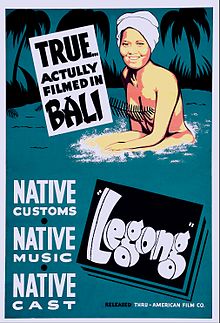Legong: Dance of the Virgins
| Legong: Dance of the Virgins | |
|---|---|

theatrical poster
|
|
| Directed by | Henri de la Falaise |
| Produced by | Constance Bennett |
| Written by | Hampton del Ruth (titles) |
| Cinematography | W. Howard Greene |
|
Production
company |
Bennett Pictures Inc.
|
| Distributed by | DuWorld Pictures Inc. (US) Paramount International (outside US) |
|
Release date
|
|
|
Running time
|
65 minutes |
| Country | United States |
| Language | Silent (English intertitles) |
Legong: Dance of the Virgins is a 1935 film, one of the last feature films shot using the two-color Technicolor process, and one of the last silent films shot in Hollywood.
Legong was an American exploitation film (of a type often referred to as a "goona-goona epic") similar to Isle of Paradise (1932), directed by Charles Trego, and Goona Goona or Love Powder (1932) directed by Andre Roosevelt and Armand Denis. Legong was produced and directed by Gaston Glass and Henry de la Falaise for Falaise's wife Constance Bennett's Bennett Pictures Corporation, and was filmed entirely on location in Bali from May to August 1933, using an all-Balinese cast. The crew was helped by Roosevelt, Denis, and Walter Spies to gain access to local villages and people willing to act in the film.
The cameraman was three-time Academy Award winner color specialist W. Howard Greene, billed as William H. Greene, who also photographed the two-color Technicolor scenes in Ben-Hur (1925), in addition to many other early Technicolor films. Legong was first distributed in the United States in 1935 by DuWorld Pictures Inc. and outside the U.S. by Paramount International. The score was compiled from stock cues from the Abe Meyer library, and was conducted by Samuel Wineland.
The film opened in New York City on October 1, 1935 at USD$5.00 per ticket ($84.20 in 2012 dollars). Reaction from some New York critics was positive; “exquisitely beautiful” from one, “Moments that touch the heart” from another, and “flaming splendor” from a third. The New York Times' reviewer found it "a pleasant venture in the filmic literature of escape... a pretty tale, and the photoplay recites it simply and with faith. Subduing his color camera to inviting browns and pastel tints, the Marquis sets his native lovers against the rice fields, the shadowy lagoons, the pounding surf and the mountains of that island of which Paul Morand has written that it is absolutely irresistible to college boys and women of 40." Variety, on the other hand, considered it to offer "nothing especially refreshing in the story... follows usual procedure for this type of native stuff" though conceding "A number of elaborate production scenes with oriental trappings are made doubly effective through use of color".
...
Wikipedia
